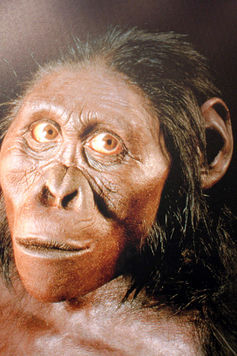How could scholars determine how long A. africanus breastfed? Like trees, teeth contain growth rings that can be counted to estimate age. Teeth rings also incorporate dietary minerals as they grow. Breast milk contains barium, which accumulates steadily in an infant's teeth and then drops off after weaning. In a new study, researchers analyzed trace minerals in two sets of fossilized A. africanus teeth from the Sterkfontein Cave outside Johannesburg, South Africa.
They found patterns of barium accumulation, suggesting that infants of this early human species likely breast fed for about a year--an interval which may have helped them overcome seasonal food shortages. A. africanus lived in southern Africa more than 2 million years ago.

Model of A. africanus individual. flowcomm, CC BY
The species resided in savannahs with wet summers, when food was likely abundant, and dry winters, when food was scarce. Cyclical accumulations of lithium in the specimens' teeth suggest the species endured food scarcity during the dry season, which may have contributed to its eventual extinction.
Modern day great apes commonly continue to breastfeed for longer than a year but many humans do it less, likely due to cultural reasons. The introduction of infant formula was empowering for women who either could not express enough milk, did not want to breastfeed, or wanted to return to work without doing so. But today those mothers face a backlash. Some statistical studies claim better outcomes, even greater intelligence, the longer mothers breastfeed, but that is just statistical correlation, no different than someone who claims organic food causes autism or hot tea causes cancer.
Citation: Joannes-Boyau, R, et al. Elemental signatures of Australopithecus africanus teeth reveal seasonal dietary stress. Nature. DOI: 2018-09-13492E





Comments